Whether for you, your children, or your guests, lighting in a bedroom should not be left to chance when making design decisions. Proper lighting provides both function and atmosphere. Also, lighting is an excellent way to up the style quotient in your home and have your bedrooms stand out by leaning into fresh and unique ideas.
We interviewed a bevy of interior designers to get their takes on bedroom lighting—from practical tips to pretty ones. We also asked them to share some of their go-to favorites that might just be exactly what you were looking for!
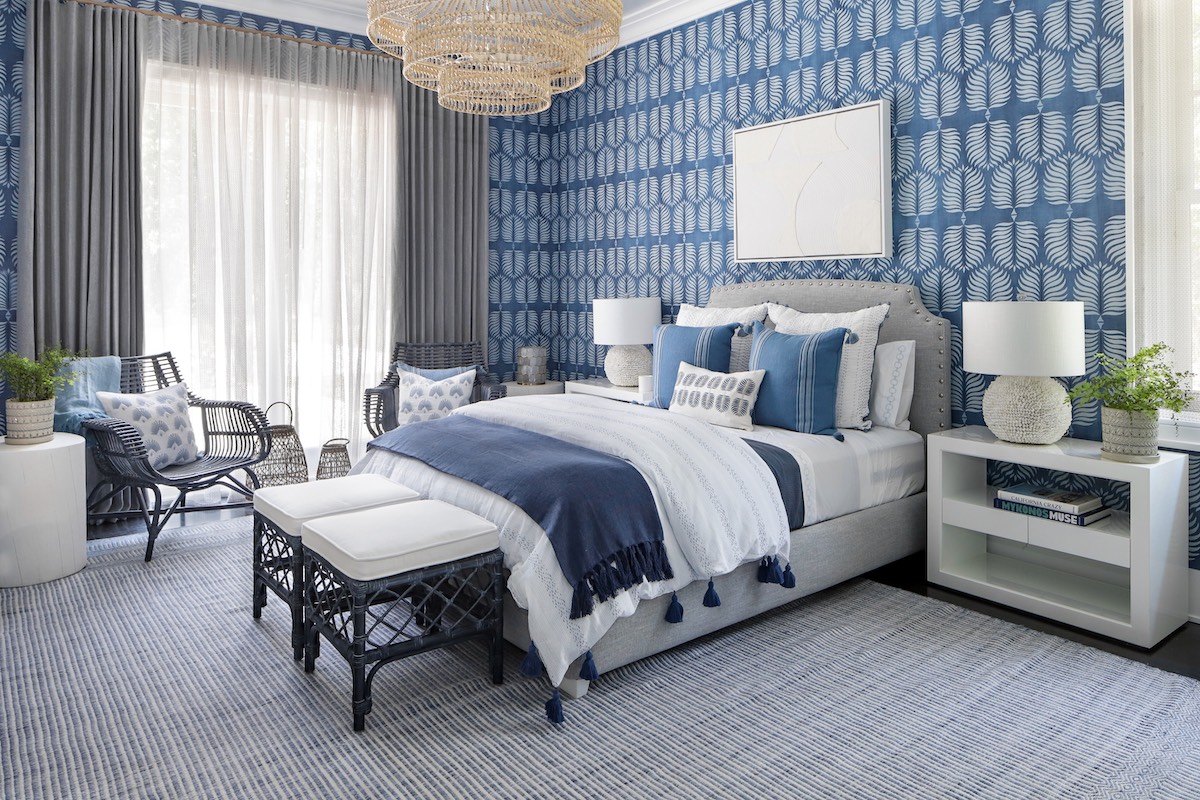
Photo by Eric Striffller Photography
New York and Palm Beach designer Mabley Handler employs a large-scale tiered pendant with bedside table lamps in a blue-infused bedroom. Lighting by Serena & Lily.
START WITH WHO AND HOW
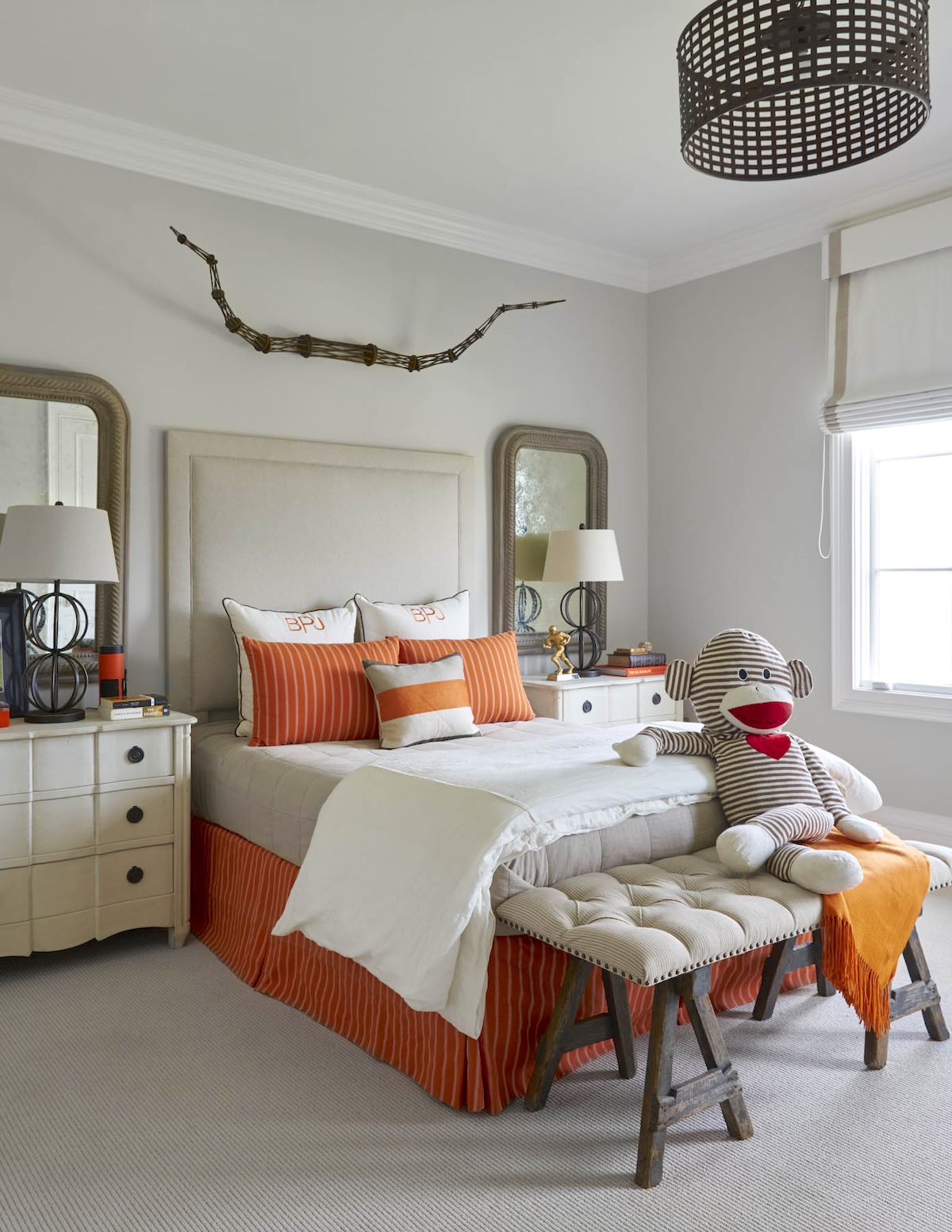
Photo by Nathan Schroder
For a child’s bedroom, Houston designer Julie Dodson used a fun, antique, black pendant with vintage iron curvy table lamps where orange tones and neutrals join hands.
Is the space for a couple, a child, or for guests, etc.? As Nashville, Tennessee, designer Blaire Murfree explains, “If the bedroom is enjoyed by two people, it is important to consider the needs of each person. Lighting in a bedroom needs to be beautiful, allow for a relaxing ambience, and also function to meet individual needs.” Birmingham, Alabama designer Danielle Balanis adds, “When it comes to a child’s bedroom, I do tend to go a little brighter and less moody, but always with an abundance of layers and lighting options.”
Julie Dodson Webster of Dodson Interiors in Houston, Texas, says, “A guest bedroom is all about a relaxing ambiance, which I often create with lamp lighting.” [See more tips for Lighting Guest Bedrooms below.]
How you use the bedroom is also important, as Augusta, Georgia, designer Lauren Robbins explains: “Asking your client about their habits and how they intend to use their home is one of the most important roles of a designer. Are they nighttime readers? Do they prefer overhead lighting? If so, having small lights positioned above a bed that can be turned on and off from a remote or switch near the bed will ensure your client can enjoy their nightly read without having to get out of bed to turn off the lights.”
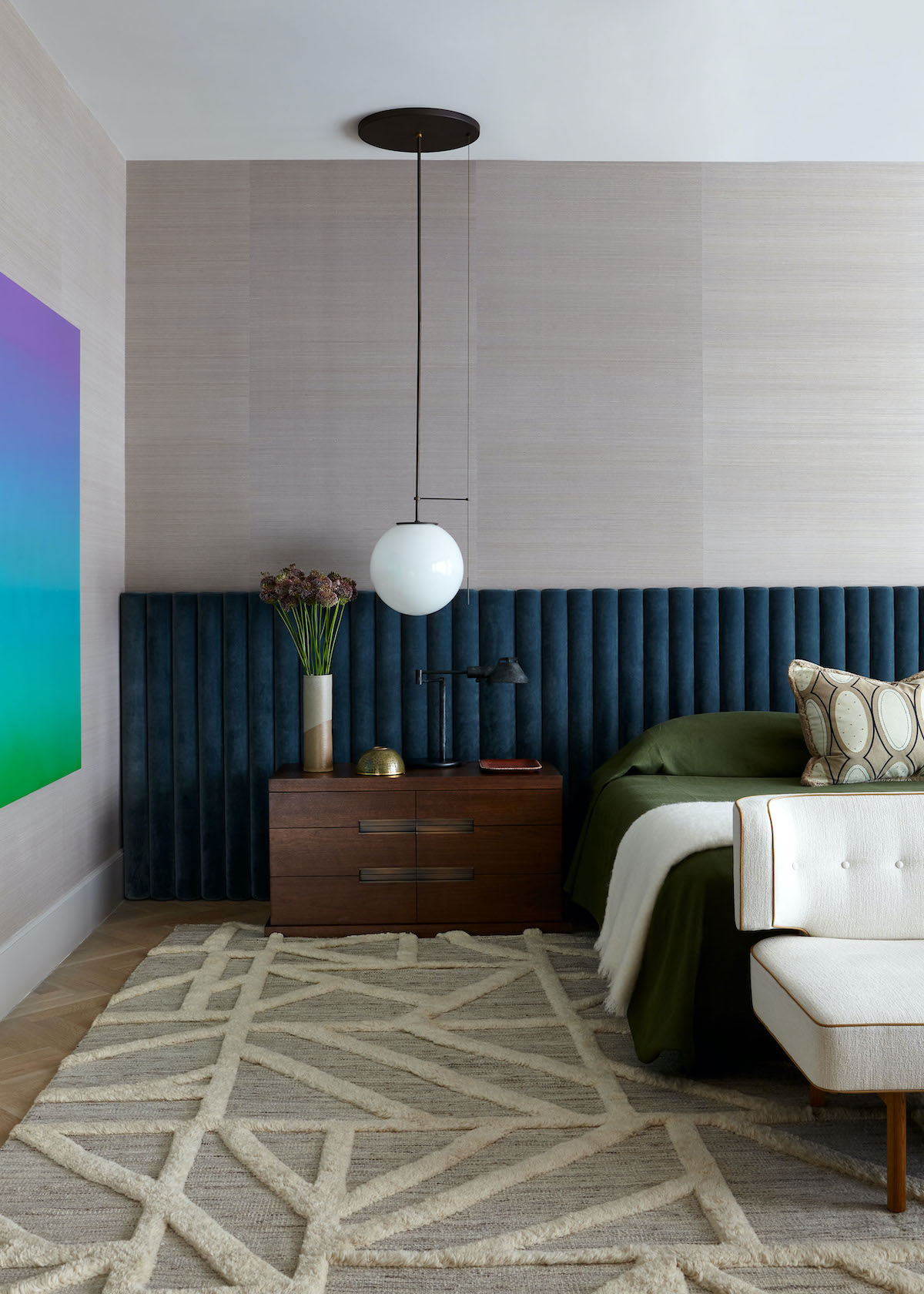
Photo by Joshua McHugh
A new trend is hanging pendant lights bedside. New York and Connecticut-based Dumais Interior Design outfitted this streamlined bedroom with orb pendants and swing arm task lights against a chic upholstered wall treatment. Pendant by Workstead; lamp by Nessen Lighting.
New York lighting designer Charlie Dumais asks these questions: “How do you want your bedroom to feel? How do you use your bedroom? Do you have a desk area? A reading area? A dressing area? Do you have artwork that you love or any interesting details about the space?” He adds another important tip: “Always switch each light fixture separately! Sometimes you want to get into bed and read, so you don’t need the ceiling light on. Having everything on dimmers is also really important. When you start to wind down for the evening, you want less lighting. Dimming the lights helps you relax by lowering the energy level in the space.”
Designer Bethany Adams of Louisville, Kentucky, shares this advice: “The lighting needs of a bedroom are dependent on how many functions the room serves. For example, do you dress in the room or have a small home office in one corner? In that case, you’ll need functional lighting around the perimeter of the room. If you have a separate dressing room and office, a single, decorative fixture at the center should provide plenty of ambient light. Bedside lamps or sconces are a must for reading, but pay close attention to how and where these are turned on and off. You want to be set up for a restful transition to sleep.”
LAYERING BEDROOM LIGHTING
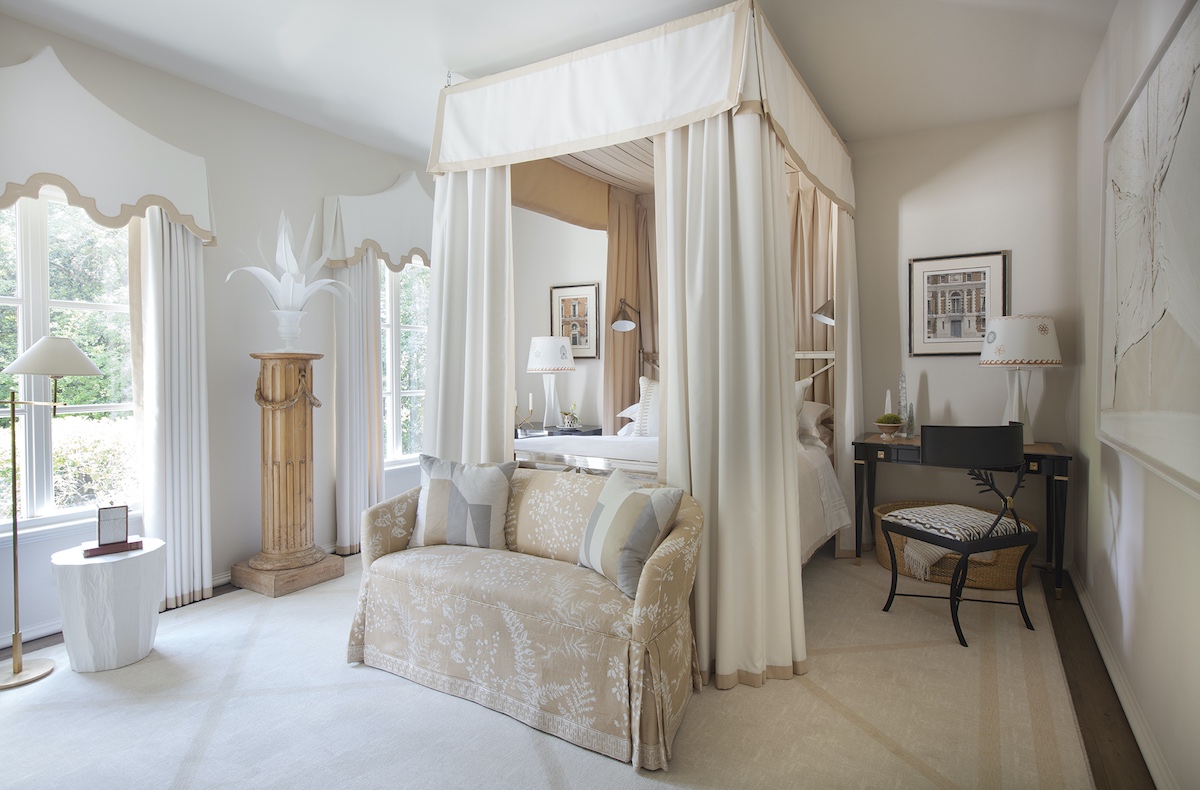
Photo by Sarah Winchester Studios
For a glamorous primary bedroom in a symphony of neutrals, Dallas designer Josh Pickering included swing-arm lamps tucked within the bed hangings, along with bedside lamps. Lighting by Visual Comfort.
How much light is enough? Lighting designer Charlie Dumais offers this guide: “Every bedroom should have a minimum of three sources of occasional light. Think of this as a triangle. One source of light on either side of the bed, and one source in a corner opposite the bed. This can be two lamps or sconces on either side of the bed and a floor lamp or table lamp in a corner reading spot or dresser opposite the bed. Center ceiling fixtures are typical, but I prefer decorative table and floor lamps for most use. Center fixtures are great for finding that sock you dropped or for straightening up, but they are not great for creating a mood.”
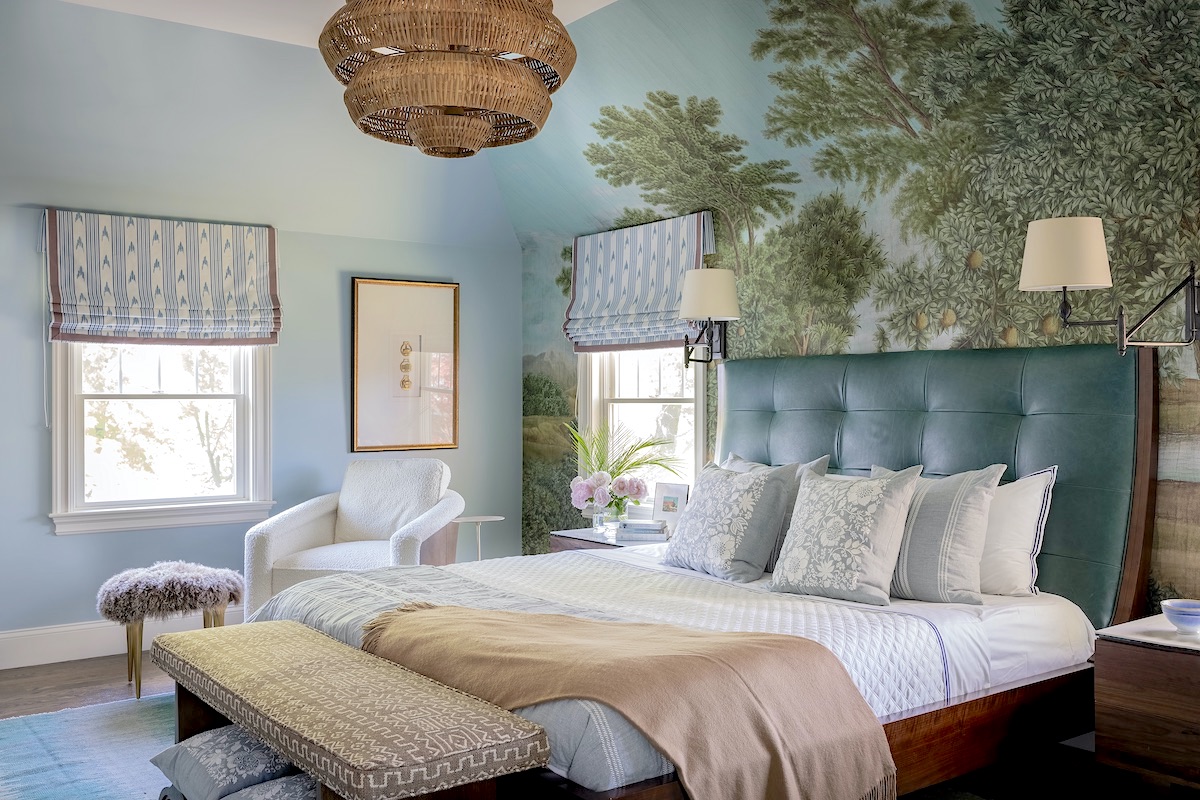
Photo courtesy of Currey & Company
A leather headboard sits over scenic wallpaper along with a bold, tiered chandelier and swing-arm lamps from Boston area designer Robin Gannon. Lighting: Antibes Natural Chandelier from Currey & Company, lamps from Visual Comfort.
For Dallas area designer Callie Windle, flexibility is key. “I love reading by lamplight, so I always start with bedside lamps, or, in some cases, bedside sconces. These create a beautiful glow at night, and they’re so practical. You can have a light on while your partner is asleep,” she says. “I also recommend a floor lamp or two. Lighting is all about layering, so consider how to ensure there is light at every level and for every activity. Having five or more sources in a room gives you great flexibility.”
SCALE
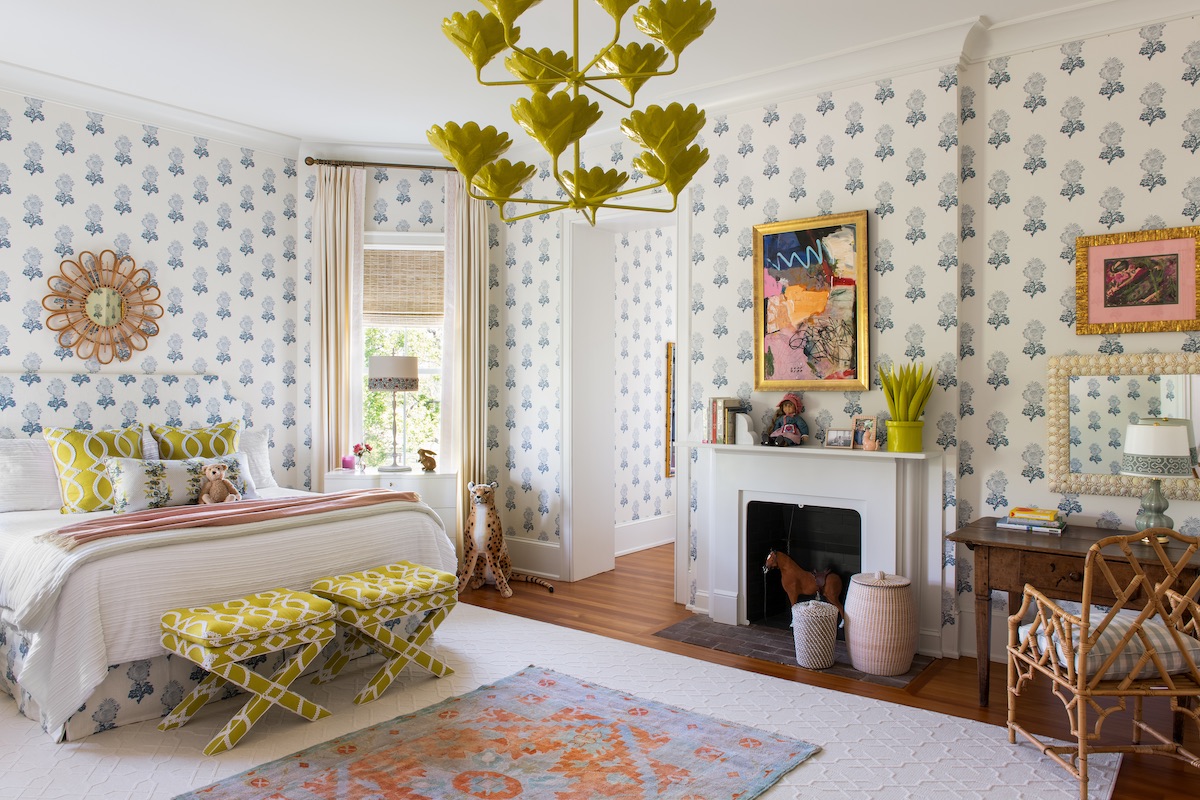
Photo by Katie Charlotte
This lively bedroom crafted by Lexington designer Isabel Ladd with a mash-up of color and pattern shows off a tiered chandelier with botanical vibes, along with a bedside table and desk lamps with pretty shades. Lighting: chandelier by Stray Dogs.
The proper scale is important in every design decision. Birmingham, Alabama, designers Anna Still and Marguerite Johnson of Still Johnson share a great tip when it comes to scale. “Before purchasing any important decorative lighting, we recommend making a full-size template of a fixture to try in the space,” they say. “We see a lot of lighting mistakes due to scale, especially with fixtures that are far too small or too large for a specific space. It’s an easy mistake to make; it’s very hard to envision true three-dimensional scale from a spec sheet, and there are a variety of factors from ceiling height to room size that affect the size requirements. Making templates adds an extra step, but we have caught a lot of scale mistakes this way.”
Dallas, Texas, designer Josh Pickering has this advice: “I always find ceiling lighting to be tricky in bedrooms. If the bedroom is large, a chandelier is a great addition, but if it’s small enough where the chandelier would encroach over the foot of the bed, I find that incredibly awkward. Also, if ceilings are not tall, the space between a mattress and the bottom of a fixture can feel really short really fast.”
PERSONAL STYLE

Photo by Dan Cutrona
A very posh bedroom by Boston area designer Robin Gannon includes a wall of drapery and three types of lighting: a mesh-like chandelier, ceramic table lamps, and sconces attached to the wallpaper. Lighting: Bunny Williams Home table lamps; Arteriors wall sconces; Global Lighting ceiling fixture.
Above all, make it yours! Anna Still and Marguerite Johnson share this advice: “Think of lighting as the jewelry of the house, while the furnishings are the outfit. Some clients may be comfortable with a bold pair of colorful chandelier earrings, and some clients may opt for a simple pair of diamond studs. Either choice could work with the same outfit, but it’s the choice that shows the wearer’s personality and style.”
TYPES OF BEDROOM LIGHTING
CEILING LIGHTING
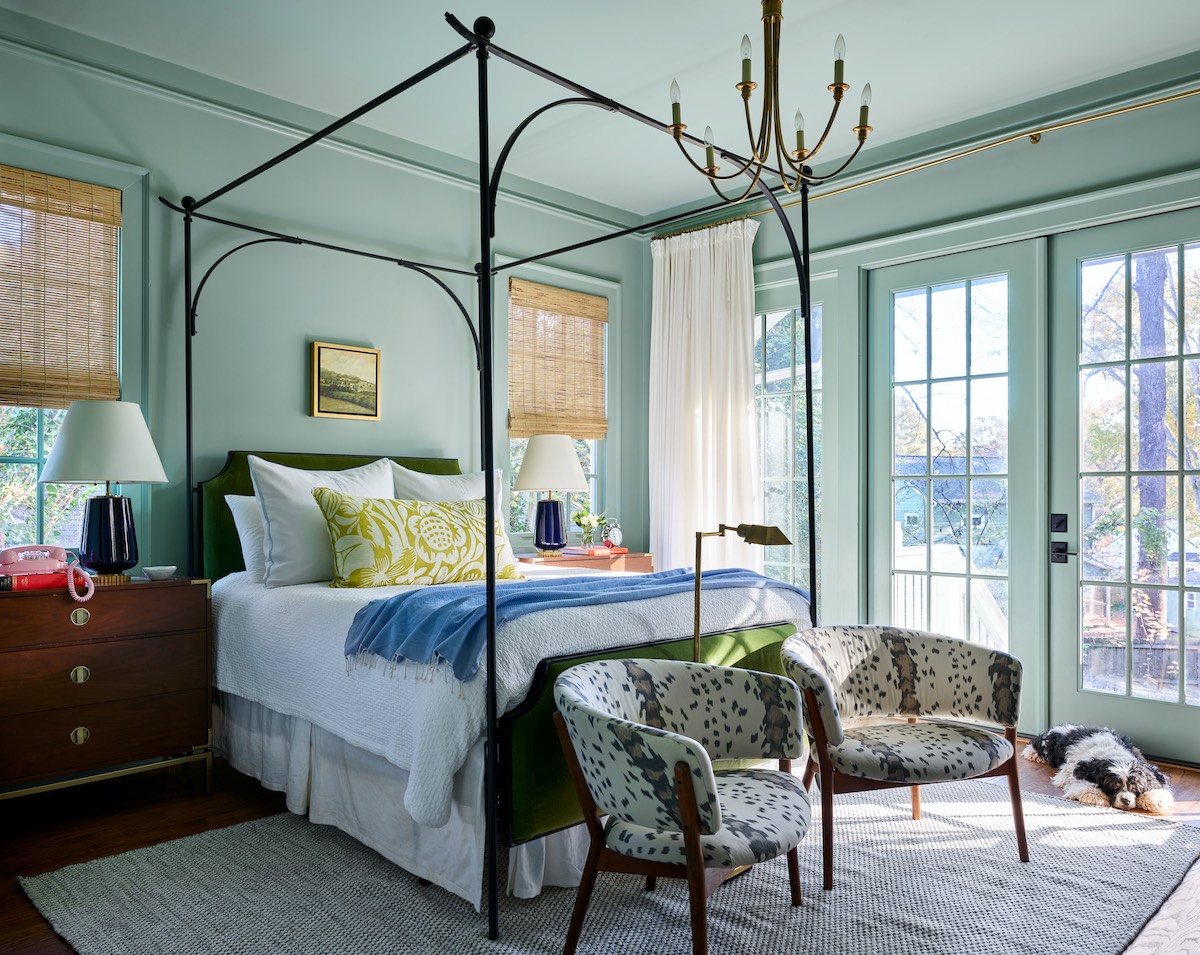
Photo by Emily Followill
A color-wrapped main bedroom by Atlanta designers Gordon Dunning makes sure lighting needs are always at the ready—a six-armed graceful chandelier, table lamps, and a reading lamp between two armchairs. Lighting: bedside table lamps and floor lamp by Visual Comfort.
Most of the designers we interviewed love a statement-making chandelier or pendant to create some drama if it makes sense—always on a dimmer of course! However, they explain that there are some considerations to take into account.
Callie Windle, a designer in the Dallas area, notes, “While I personally don’t use overhead lighting in a bedroom very often, it’s still useful. Whether you’ve lost an earring or want to turn on all the lights to clean or make your bed, you need a way to light up the whole room quickly.”
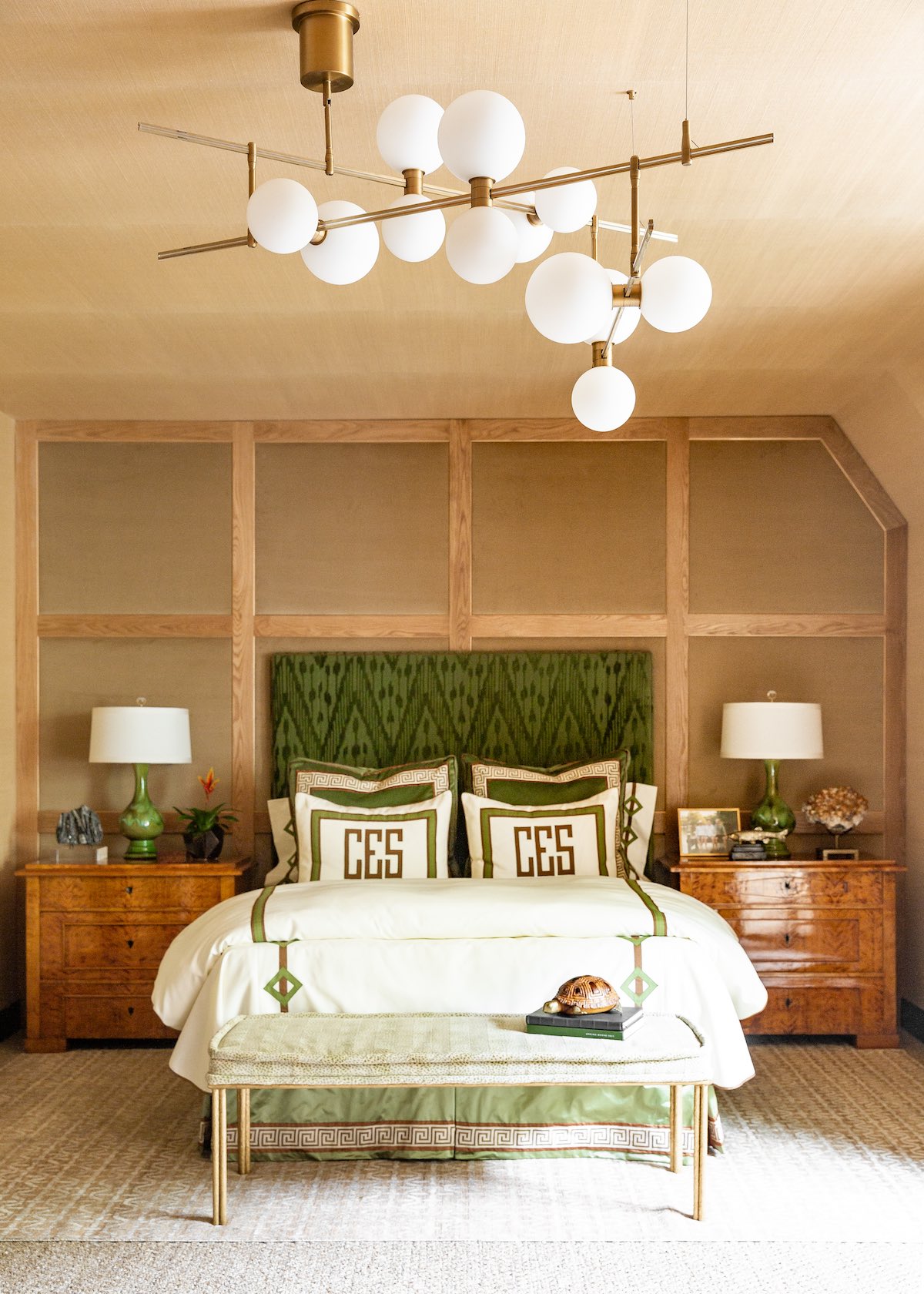
Photo by Jen Morley Burner
Fort Worth designer Trish Sheats creates balance and drama in a guest room with ceramic bedside table lamps and a bold contemporary sputnik-like ceiling light fixture. Lighting by Visual Comfort.
Boston, Massachusetts, designer Robin Gannon only uses recessed lighting in limited cases like if she has window bays that can’t be lit otherwise. “I also use it if I am trying not to oversize the chandelier in a large room where the ceiling isn’t very high, or sometimes to avoid dark corners in a room. But the idea is to provide a lot of nice soft lighting.”
Designer Annie Kersey of Purple Cherry Architects in Annapolis, Maryland, offers advice for people who need a ceiling fan: “If a client prefers a ceiling fan as opposed to a lighting fixture (whether they need it for sleeping purposes or just like to have the option of an overhead), I will look to add more decorative lighting through using swing-arm sconces, table lamps, and floor lamps throughout the space.”
BEDSIDE LAMPS
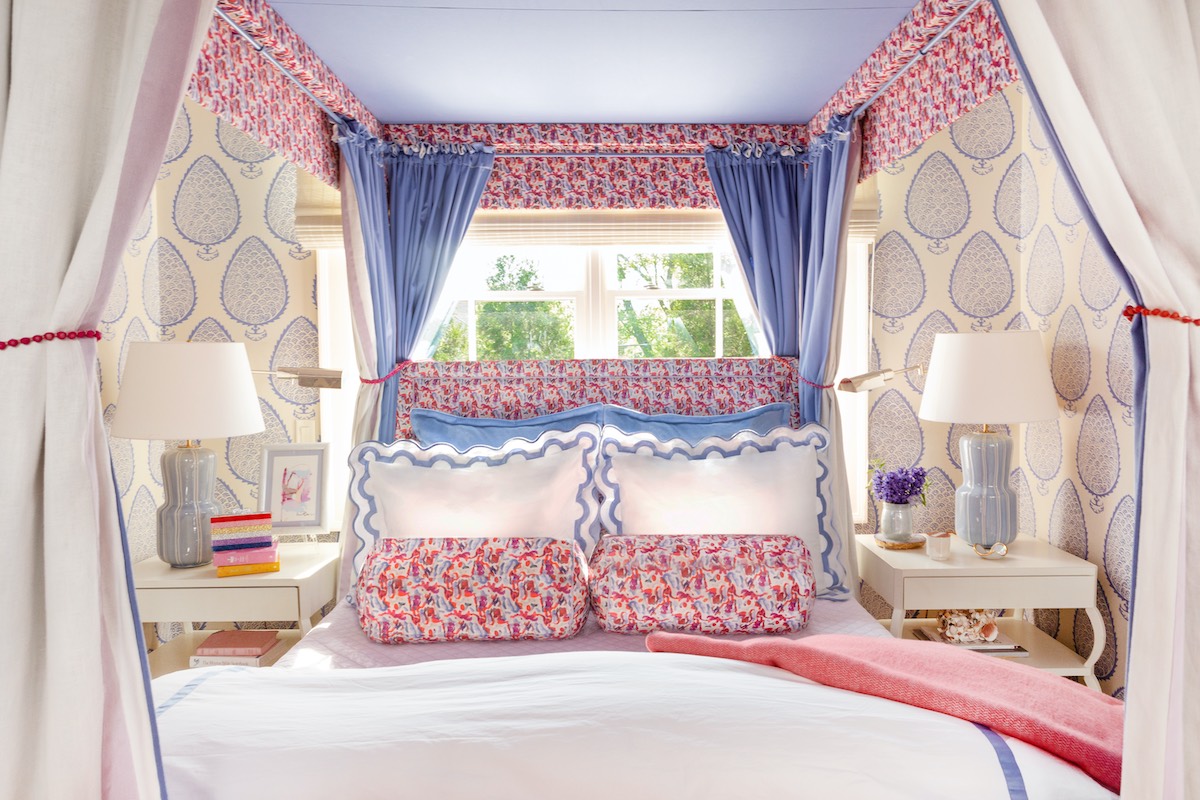
Photo by Leslee Mitchell
In a snug, wallpapered bedroom with red, white, and blue bed hangings, Nashville designer Blaire Murfree chose a combination of table and swing-arm lamps for versatility. Lighting by Visual Comfort.
Designers love lamps and sconces in a bedroom, but there are some thoughts to keep in mind. Birmingham, Alabama, designer Danielle Balanis advises, “Bedside table lamps should never be too massive. It will make the room feel chunky and blocky and very obtrusive. If tall, go skinny, but make sure to have the bedside lamps scaled to the room.” Nina Long and Don Easterling of Mathews Design Group add, “The size of the lamp really depends on the nightstand. You don’t want the shade to be huge if the nightstand is small, so the scale is important. Also, you don’t want a super tall lamp either; it really needs to be able to be reached from laying down.”
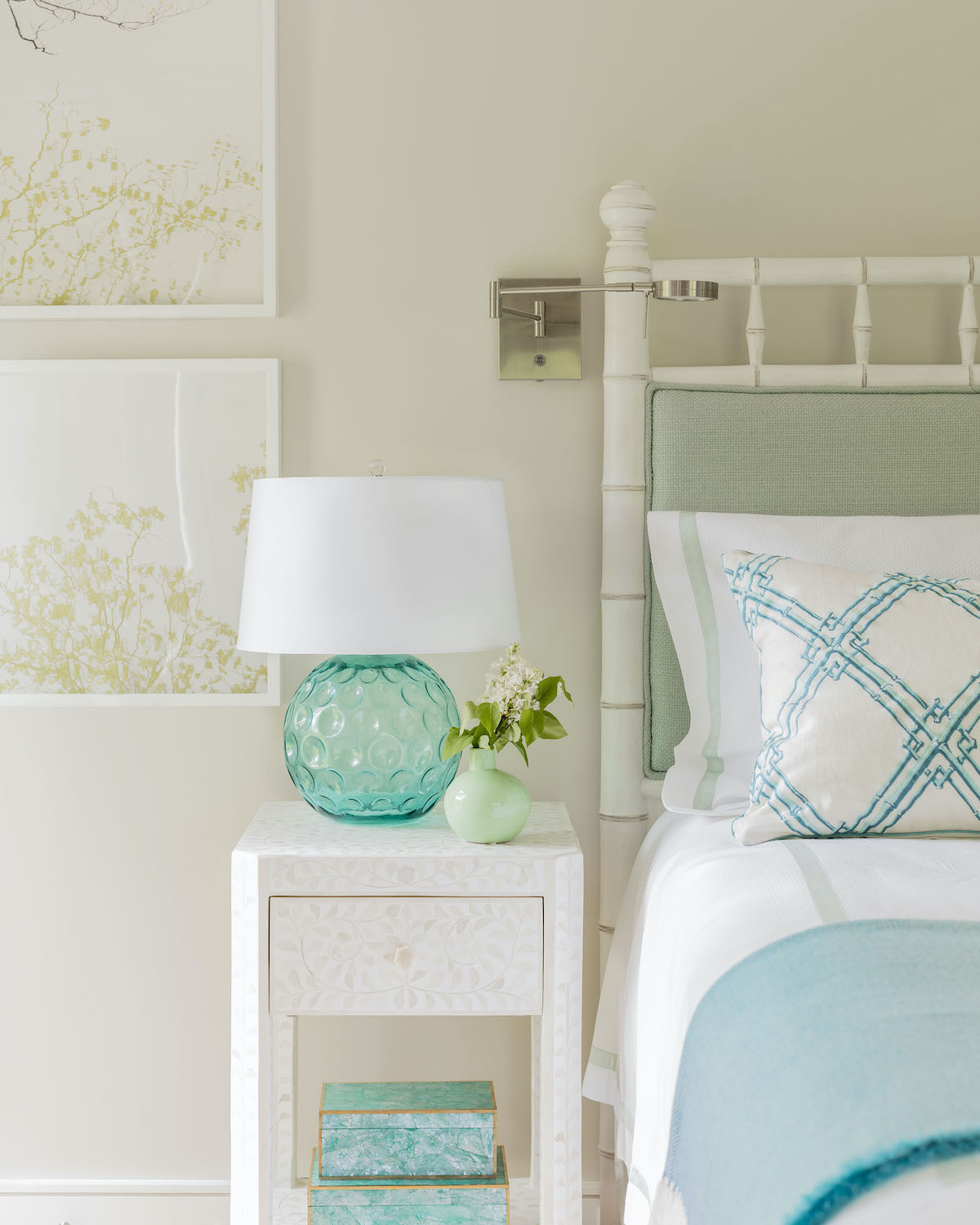
Photo by Michael J. Lee
In a light and bright coastal-feeling bedroom, Robin Gannon included dimpled glass lamps with chrome swing arms, a favorite pairing of designers. Lighting: lamp by Arteriors; swing arm by Visual Comfort.
New York designer Lisa Frantz has this to offer: “Bedside lamps are a place to add some fun and drama to a primary bedroom. This is a great way to insert some color and pattern into the design, especially with lampshades. The main detail to pay attention to when selecting bedside lamps is to note the height of the headboard and the bedside tables. Varied heights make things interesting!”
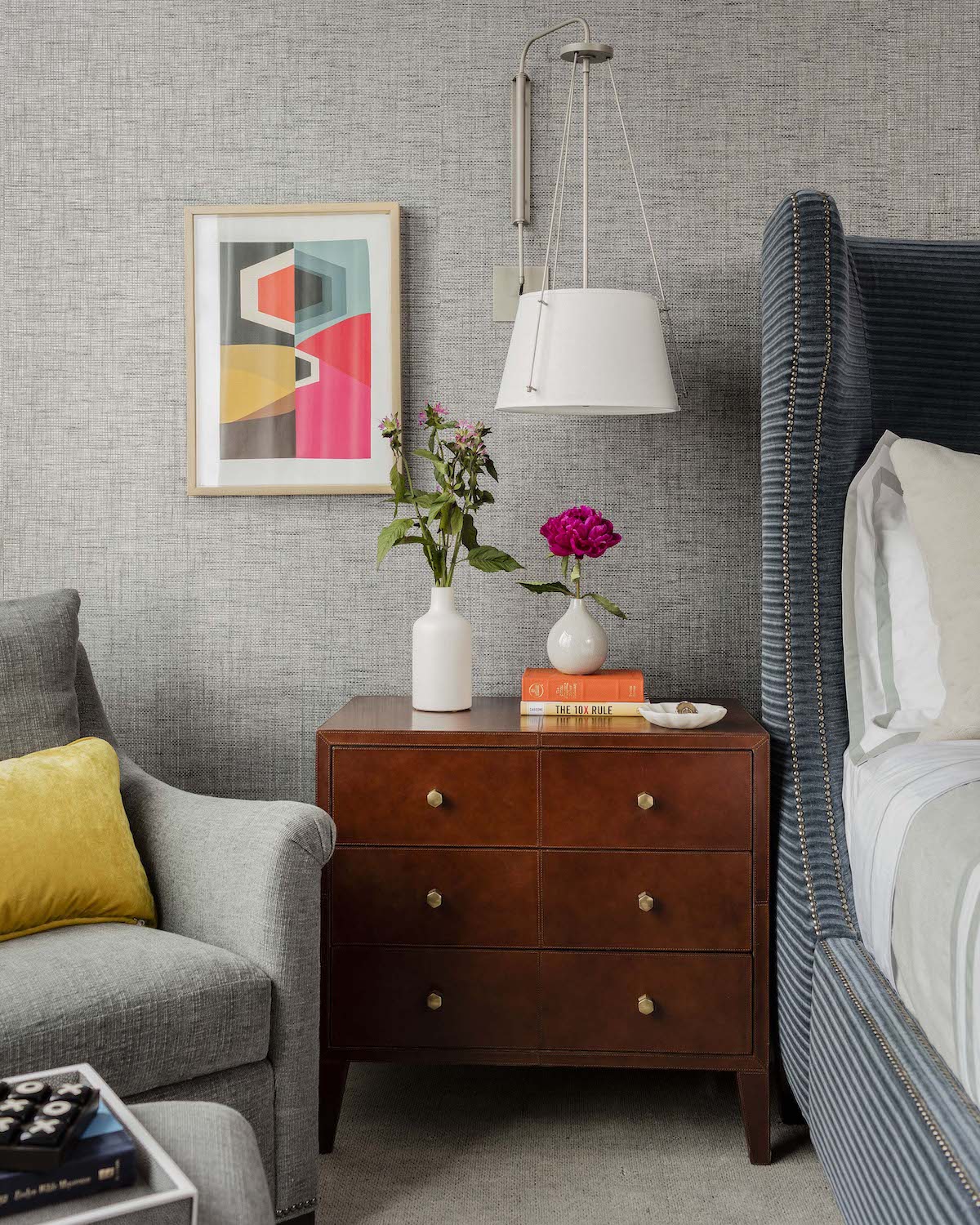
Photo by Michael J. Lee
Boston area designer Robin Gannon hung contemporary sconces for bedside reading against a gray upholstered wall with jolts of color in the mix. Lighting by Urban Electric.
Atlanta, Georgia, designer Beth Meyer notes a new trend in bedside lighting: “We are seeing a lot of pendants being used in place of bedside lamps or sconces. They create a new twist on the bed wall concept.”
SWING-ARM LAMPS
Swing-arm lamps are practical and stylish—a win win. But dimensions are important as Palm Beach designer Caitlin Kah notes: “The height of a swing-arm lamp should match the height of a bedside lamp. I do not like a bedside or swing-arm lamp to be taller than 30 inches.”
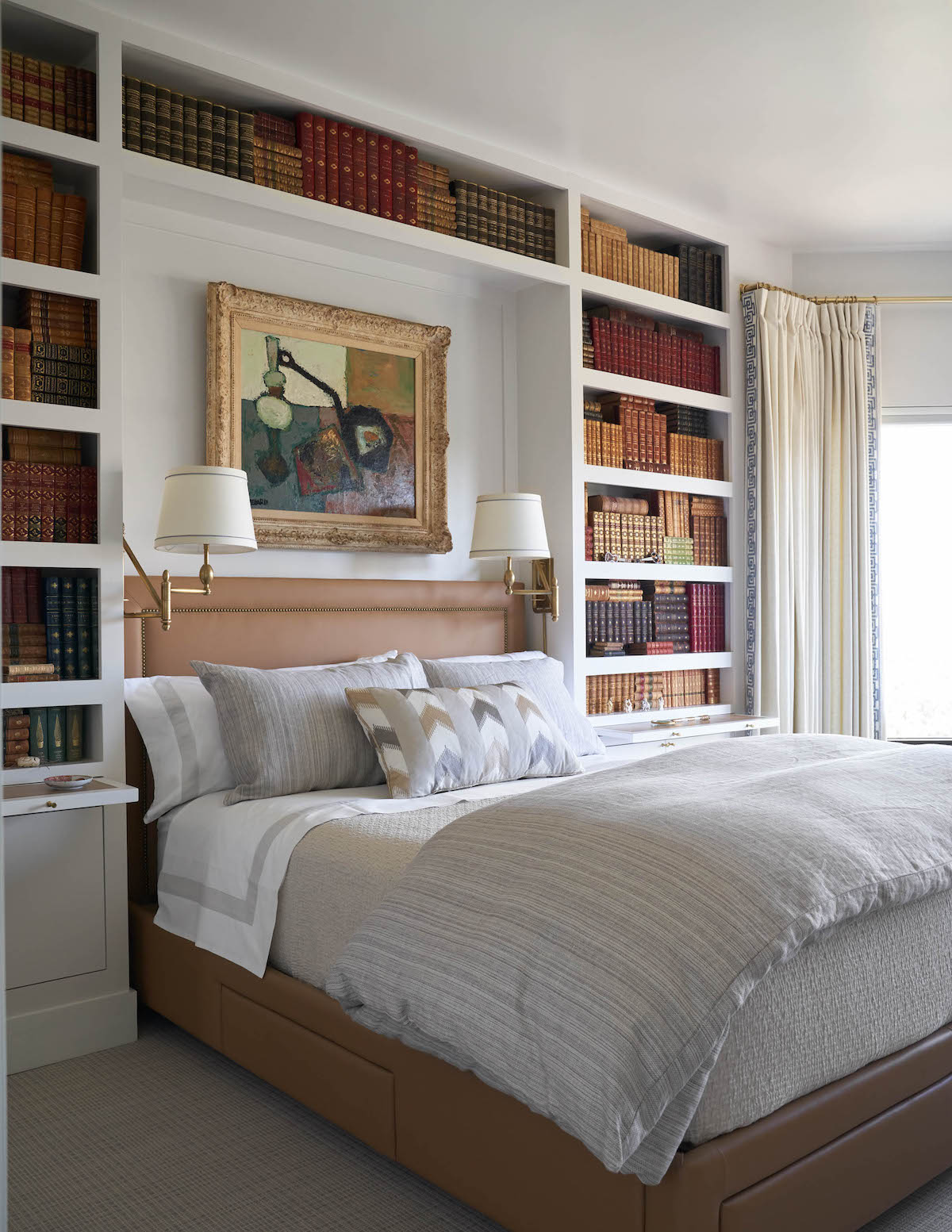
Photo by Nathan Schroder
Swing-arm lamps are perfect in this bedroom that doubles as a library created by Dallas interior designer Josh Pickering. Lighting by Visual Comfort.
“We love using swing-arm lamps at the bedside for a number of reasons,” says Gordon Dunning of Houston, Texas. “If space is limited, they help clear up room on a bedside chest that would otherwise be hosting lamps. For the partners that have a late-night reader and an early snoozer, we find the ability to swing the lighting closer to oneself to be a welcome feature. Aesthetically, we also like adding a fun lampshade to enhance the overall design of the space. It is very important to have a switch at the bedside so that when one starts falling asleep reading, you don’t have to get up to turn off the lights!”
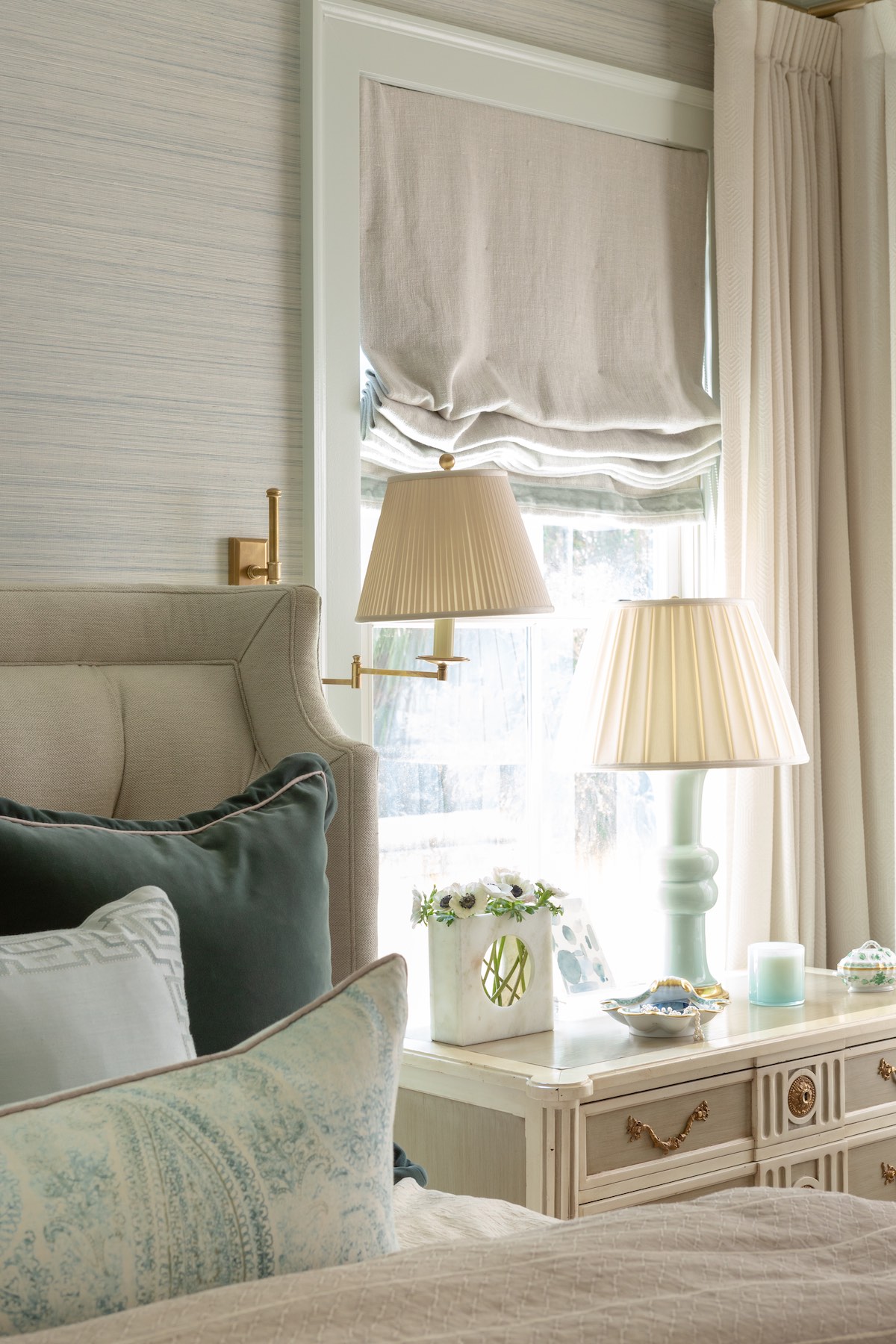
In a traditional bedroom dressed in pretty neutrals, Nashville designer Blaire Murfree included a brass swing-arm lamp with a pleated shade and a pale blue table lamp. Lighting: antique swing-arm lamp from Lumens (Nashville), shade from Penney Morrison.
Fort Worth designer Trish Sheats notes, “You must keep the proportions of the bed, bed frame, and lamp in consideration. In proportion to the mattress, make sure the shade height works for the client so that if the client is sitting in bed trying to read, it is not too low. If the swing-arm lamps are too high, they are uncomfortable as they are in direct eyeline.”
New Orleans designer Hattie Sparks reminds us to consider functionality: “How far out does the arm extend? You want to be sure that if you’re actually using it as it’s supposed to function that the lamp can extend out and over toward the mattress. If it’s purely decorative, the extension doesn’t matter too much. Also, what does it look like when it’s totally collapsed? You want to make sure the arm doesn’t butt up against a door frame or wall.”
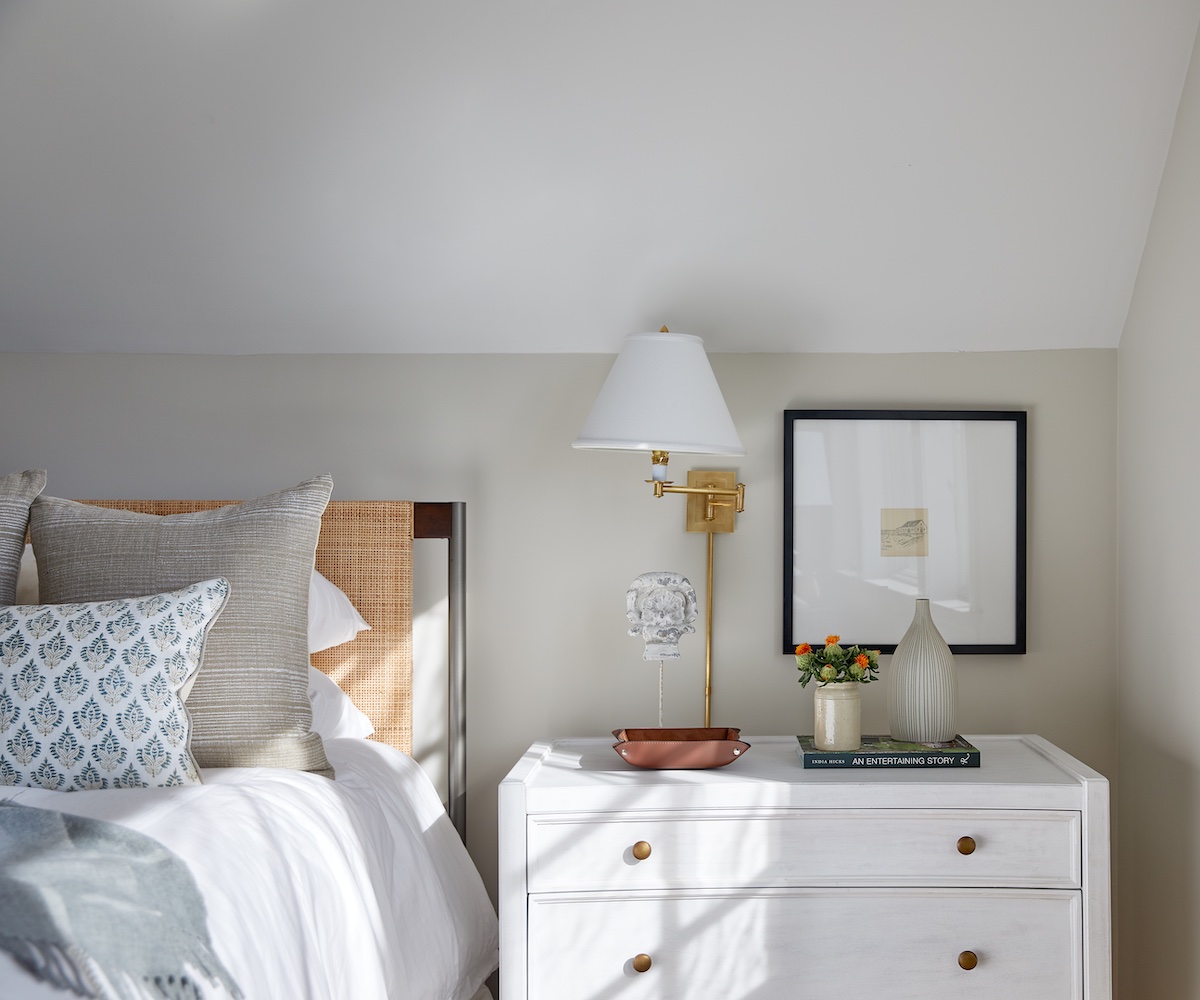
Photo by Liz Daly
Using swing-arm lamps is a great way to free up bedside table space to create a vignette and include artwork as seen in this bright bedroom by Angela Hamwey of Mackenzie & Co. Lighting by Visual Comfort.
And what about wiring for swing-arm lamps? New York designer Leslie Banker notes, “Consider whether it will be hardwired into the wall or if it will have a cord that plugs in. Hardwired bedside lights are generally installed as part of a renovation. Swing-arm lamps with cords and cord covers offer more flexibility.”
LAMP SHADE STYLE
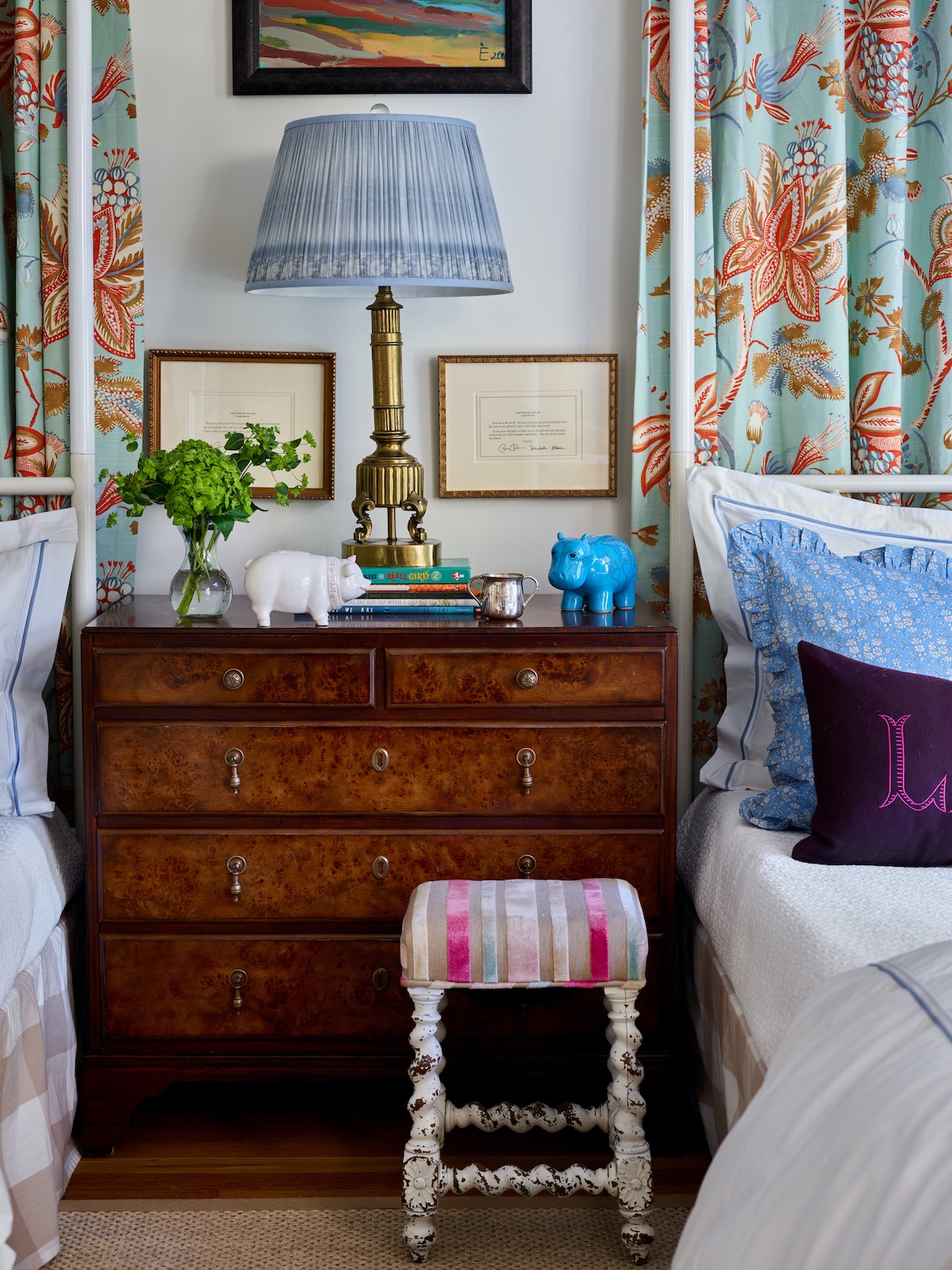
Photo by Emily Followill
Lamp shades are another way to add a custom look in a room and play into the existing color scheme such as this blue beauty used bedside in a bedroom designed by Gordon Dunning. Lighting: vintage lamp with shade by Edgar Reeves.
When selecting lamps, don’t forget about your shades! Annie Kersey of Purple Cherry Architects in Annapolis, Maryland, shares her preferred choice: “Diffused shades are easier on the eyes, and I’m always drawn to linen shades for a bedroom. They provide a soft and relaxed vibe.” Birmingham, Alabama, designer Ellie Christopher has this advice: “Get rid of the paper shades and invest in a quality shade—stretched linen or silk, box or knife pleated. The way light goes through linen or silk creates the most beautiful glow. A soft glow of light is more attractive to live in.”

Photo by Max Kim Bee
New York designer Ashley Whittaker took a glass cylindrical lamp and topped it with a custom shade that seamlessly slips in the pink scheme of a girl’s bedroom.
Danielle Balanis adds, “Use bedroom lighting as a creative opportunity. Turn to companies like Newport Shade Company with pre-made stunning shades or Cruel Mountain Designs that can fabricate a custom shade to implement or reinforce pattern and warmth in your bedroom.” Another fan of custom shades is New Orleans designer Hattie Sparks: “I love to use custom lampshades, especially those from Charlottesville Shade Shop, Rosi de Ruig, and Etsy. They completely transform a fixture and make it one of a kind.”
LIGHTING GUEST BEDROOMS
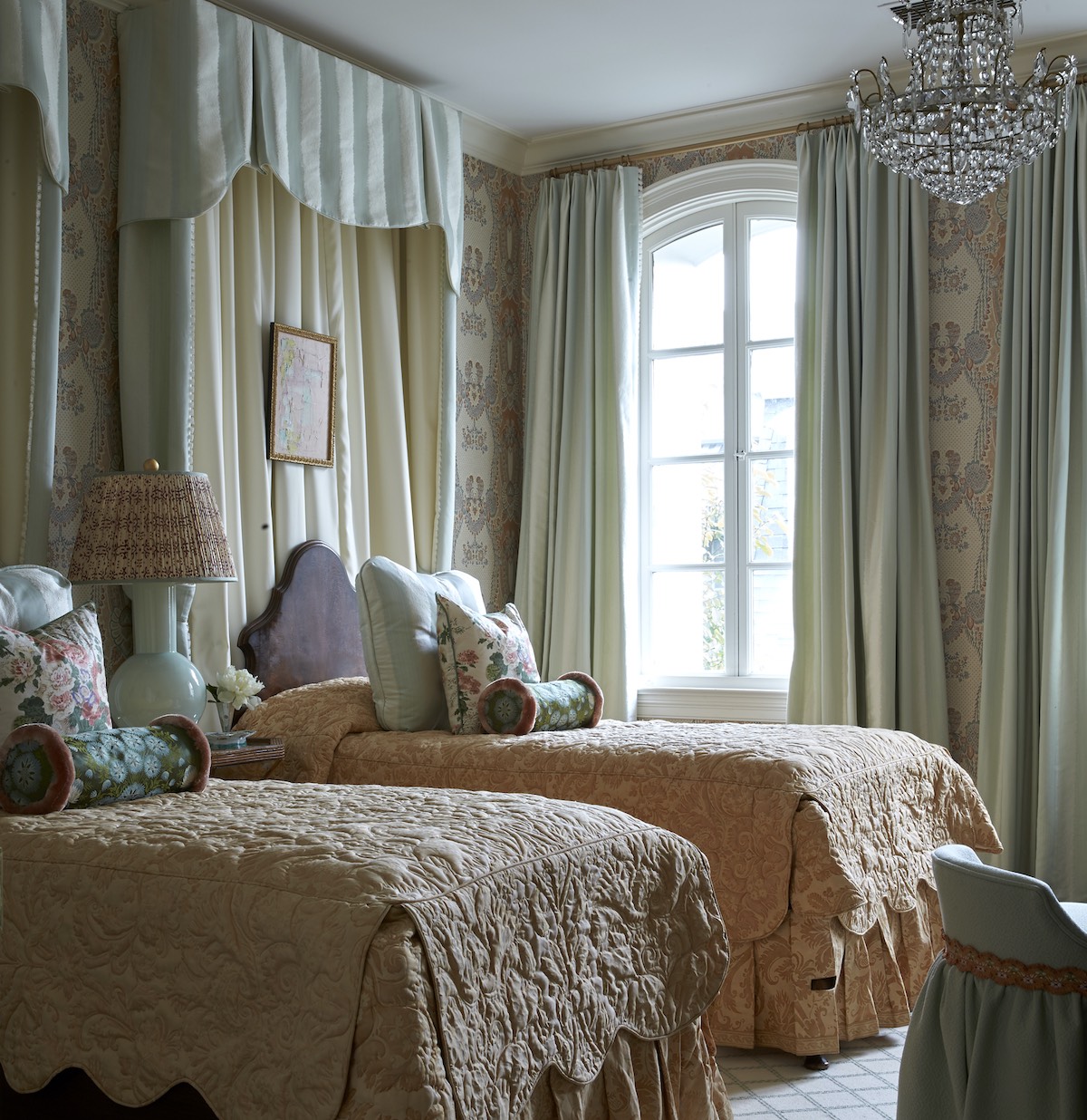
Photo by David Hillegas
Many designers like to include more than one bed in a guest room for versatility. Nashville designer Blaire Murfree placed the headboards against ceiling-height pleated drapery and added a crystal chandelier and a bedside reading lamp. Lighting: Christopher Spitzmiller lamp with shade by Edgar Reeves (Atlanta), chandelier is antique.
Most designers we interviewed treat a guest room just like the primary bedroom, but lighting designer Charlie Dumais has a different thought. “Primary bedrooms are generally larger and have more stuff, so they require more lighting. For guest rooms, keep it simple. You don’t want guests struggling to figure out how to operate the lighting in a room,” he says. “Also, turn on the lighting prior to your guests arriving. Set the light level so it’s welcoming, and let them know where a hidden switch might be. Make sure the controls are accessible and they can easily plug in chargers. You can go the extra step and provide chargers. Think of it like a hotel. How would you like to arrive? What might make your stay more pleasant or convenient?”

Photo by Stephen Karlisch
Dallas designer Denise McGaha put together a guest room with a bold striped custom headboard, floral curtains and bedside lamps, topped with custom shades and a globe-style pendant lamp. Lighting: lamp by Currey & Company; pendant by Visual Comfort.
Nashville designer Blaire Murfree has this advice: “In a primary bedroom, we know who is going to be sleeping there each evening, so we discuss preferences and rituals with our clients when we are devising a lighting and decoration plan. Does he read while she needs it dark to watch a Netflix show on her iPad or to turn in early for some extra shut-eye? Appropriate lighting can allow for this,” she says. “In a guest bedroom, we are thinking more about general comfort of those who are only enjoying the room for a few days. We will always include dimmable bedside lamps or bedside sconces, but maybe we don’t do both in a guest room space. Instead, we might opt for a floor lamp by a chaise lounge that could be used to read.”
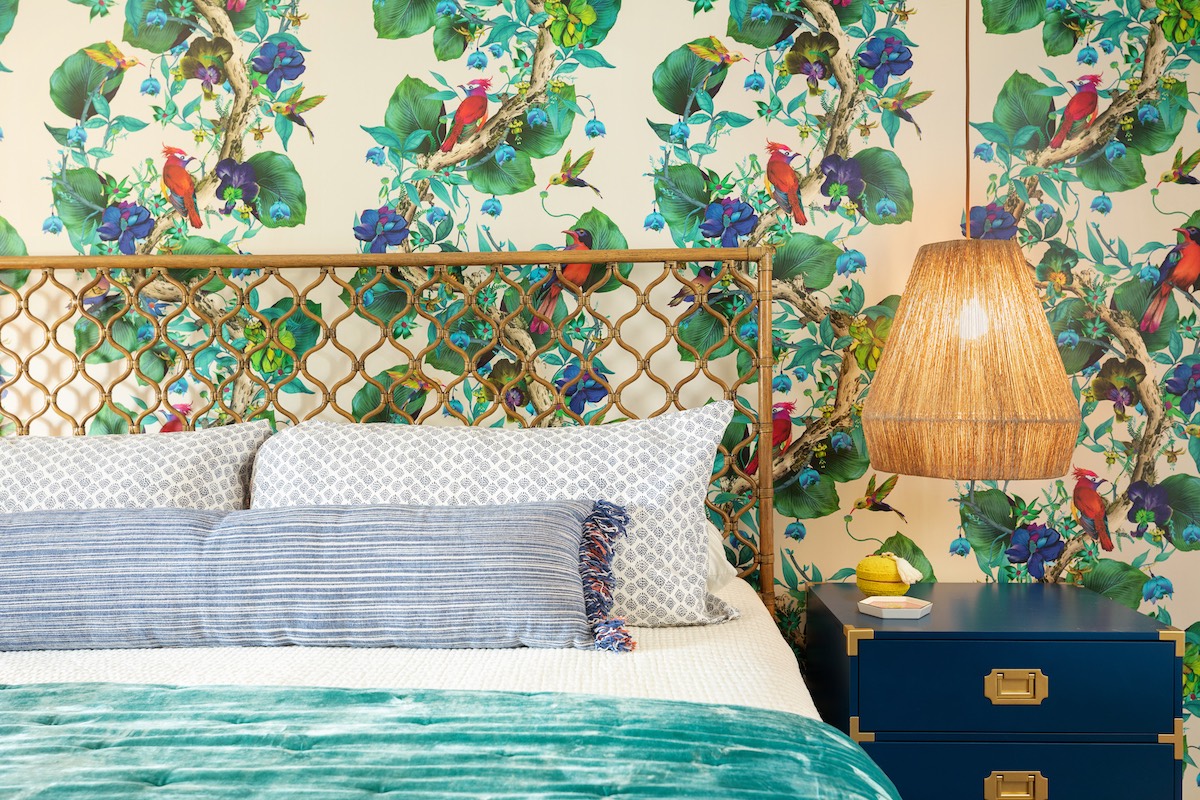
Photo by Andrew Kung
“I usually take more risks and make funkier lighting choices in a guest bedroom than a main bedroom. For instance, in this guest room, I opted for lights hung from the ceiling above the nightstands, as opposed to the usual suspects of bedside lamps," says Lexington Kentucky designer Isabel Ladd. Lighting by Woven.
“I suppose I use more ‘wow-factor’ fixtures in the primary bedroom. But you must consider the comfort and functionality of lighting for your guests,” says Los Angeles designer Barclay Butera. “I suggest staying in the room yourself one night to see how comfortable you are, and to see if the lighting works for you. You will be surprised that what looks pretty doesn’t always cut it!”
By Alice Welsh Doyle
MORE FROM THE DESIGN EXPERTS IN THIS FEATURE
Angela Hamwey of Mackenzie & Co. – Instagram: @mackenziestudio
Anna Still and Marguerite Johnson of Still Johnson – Instagram: @still.johnson
Annie Kersey of Purple Cherry Architects – Instagram: @purplecherryarchitects
Ashley Whittaker of Ashley Whittaker Design – Instagram: @ashleywhittakerdesign – Read more at “Meet Ashley Whittaker”
Barclay Butera of Barclay Butera Interiors – Instagram: @barclaybutera ; “Revival at L’Auberge Del Mar”
Beth Meyer of Beth Meyer Design – Instagram: @bethmeyerdesign
Bethany Adams of Bethany Adams Interiors – Instagram: @bethany.adams.interiors
Blaire Murfree of Blaire Designs – Instagram: @blairedesignsllc – Read more at “To Town from Country”
Caitlin Kah of Caitlin Kah Interiors – Instagram: @caitlinkah
Callie Windle of Callie Windle Interiors – Instagram: @calliejwindle
Charlie Dumais of Dumais Made – Instagram: @dumais_charlie
Danielle Balanis of Danielle Balanis Design – Instagram: @daniellebalanis_design ;
Denise McGaha of Denise McGaha Interiors – Instagram: @denisemcgaha – Read more at “Design Q & A with Denise McGaha”
Julie Dodson of Dodson Interiors – Instagram: @dodsoninteriors – Read more at “Meet Julie Dodson”
Ellie Christopher of Ellie Christopher Interiors – Instagram: @ellie_christopher
Gordon Dunning of Gordon Dunning Interiors – Instagram: @gordondunning
Hattie Sparks of Hattie Sparks Interior Design Studio – Instagram: @hattiesparks
Isabel Ladd of Isabel Ladd Interiors – Instagram: @isabel_ladd_interiors
Josh Pickering of Pickering House Interiors – Instagram: @joshuapickering
Lauren Robbins of Lauren Robbins Interiors – Instagram: @laurenrobbinsinteriors
Leslie Banker of Leslie Banker & Co. – Instagram: @lesliebanker
Lisa Frantz of Lisa Frantz Interiors – Instagram: @lisafrantzinteriors
Mabley Handler of Mabley Handler Interior Design – Instagram: @mableyhandler
Nina Long and Don Easterling of Mathews Design Group – Instagram: @mathewsatl – Read more at “Meet Don Easterling and Nina Long”
Robin Gannon of Robin Gannon Interiors – Instagram: @robingannoninteriors
Trish Sheats of Trish Sheats Interior Design – Instagram: @trishsheatsid – Read more at “Texas Sophisticate”



